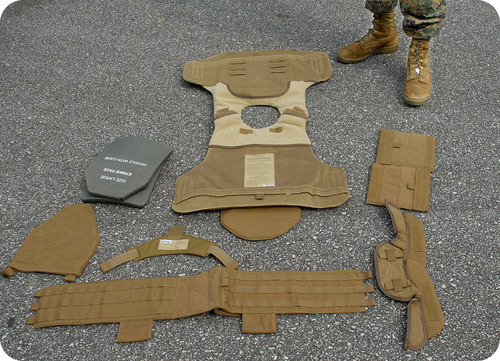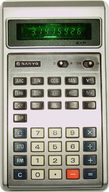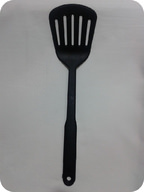1.9 材料
章节大纲
-
How does chemistry affect the clothing that we wear?
::化学对我们穿的衣服有什么影响?Chemistry is often full of surprises. One such surprise came to Stephanie Kwolek of the DuPont chemical company. She was working on a type of material known as polymers . These chemicals had been around for a while and were being used for new types of textiles. Kwolek was looking for a strong and rigid petroleum product. She came up with a material that did not look like your average polymer. But she played a hunch and had it made into threads. This new material had stiffness about nine times that of any of the known polymers of the time. Further research and development led to the production of Kevlar, a material now widely used in body armor (see figure above). In addition, Kevlar has found wide application in racing sails, car tires, brakes, and fire-resistant clothing worn by firefighters.
::化学常常充满惊喜。 DuPont 化工公司 Stephanie Kwolek(Stephanie Kwolek) 给DuPont 化工公司(DuPont)的Stephanie Kwolek(Stephanie Kwolek)带来了一个惊喜。她正在研究一种被称为聚合物的材料。这些化学品已经存在了一段时间,并被用于新型纺织业。Kwolek(Kwolek)正在寻找一种坚固的石油产品。她拿出了一种不像你一般聚合物的材料。但她弹出了一种直觉,并把它编成线。这种新材料的僵硬性大约是当时已知聚合物的九倍。进一步的研究和开发导致了Kevlar(Kevlar)的生产,这是目前广泛用于人体盔甲的材料(见上文图)。此外,Kevlar还在赛帆、汽车轮胎、刹车、刹车和消防人员穿的防火服中发现了广泛的应用。Materials
::材料材料材料Electronics
::电子Chemists are involved in the design and production of new materials. Some of the materials that chemists have helped discover or develop in recent years include polymers, ceramics, adhesives, coatings, and crystals. Liquid crystals are used in electronic displays, as in watches and calculators. The silicon-based computer chip has revolutionized modern society and chemists have played a key role in their design and continued improvement. The calculator shown below uses both a liquid crystal display and chips inside the device.
::化学家参与了新材料的设计和生产,化学家近年来帮助发现或开发的一些材料包括聚合物、陶瓷、粘合剂、涂层、涂层和晶体,液晶用于电子显示器,如手表和计算器,以硅为基础的计算机芯片使现代社会发生革命,化学家在设计和不断改进中发挥了关键作用。下面显示的计算器使用了液晶显示器和装置内的芯片。Calculator with liquid crystal display. Superconductors
::超导体Many chemists are currently working in the field of superconductivity. Superconductors are materials that are able to conduct electricity with 100% efficiency, meaning that no energy is lost during the electrical transmission, as happens with conventional conducting materials like copper cable. The challenge is to design materials that can act as superconductors at normal temperatures, as opposed to only being able to superconduct at very low temperatures.
::许多化学家目前都在超导力领域工作。 超导体是能够以100%效率进行电力生产的材料,这意味着在输电过程中不会失去能量,像铜电缆等常规操作材料一样。 挑战在于设计能够在正常温度下充当超导体的材料,而不是只能在极低温度下进行超导。Clothing
::服装服装The fibers that compose the materials for our clothes are either natural or human-made. Silk and cotton would be examples of natural fibers. Silk is produced by the silkworm and cotton is grown as a plant. Human-made fabrics include nylon, orlon, and a number of other polymers. These materials are made from found in petroleum products. Synthetic polymers are also used in shoes, raingear, and camping items. The synthetic fabrics tend to be lighter than the natural ones and can be treated to make them more water-resistant and durable.
::构成我们衣服材料的纤维是天然的或人为的。丝绸和棉花是天然纤维的例子。丝绸是由丝虫生产的,棉花是植物生长的。人造织物包括尼龙、欧伦和其他一些聚合物。这些材料是石油产品中发现的。合成聚合物还用于鞋、雨具和露营物品。合成织物往往比天然织物轻,可以处理,使其更耐水和耐久。Materials originally developed as textiles are finding a wide variety of other uses. Nylon is found in a number of plastic utensils. Taking advantages of its strength and light weight , nylon is a component of ropes, fishing nets, tents, and parachutes.
::Nylon在一些塑料用具中找到,利用它的强度和轻重优势,尼龙是绳索、渔网、帐篷和降落伞的组成部分。Nylon spatula. Summary
::摘要-
Chemists produce materials for electronics, superconducting, textile, and other applications.
::化学家生产电子、超导、纺织和其他应用的材料。
Review
::回顾-
Who developed Kevlar?
::谁发明了凯夫拉? -
Where are liquid crystals used?
::液晶在哪里使用? -
What is a superconductor?
::什么是超导体? -
What are synthetic polymers made from?
::合成聚合物是用什么制造的?
-
Chemists produce materials for electronics, superconducting, textile, and other applications.


